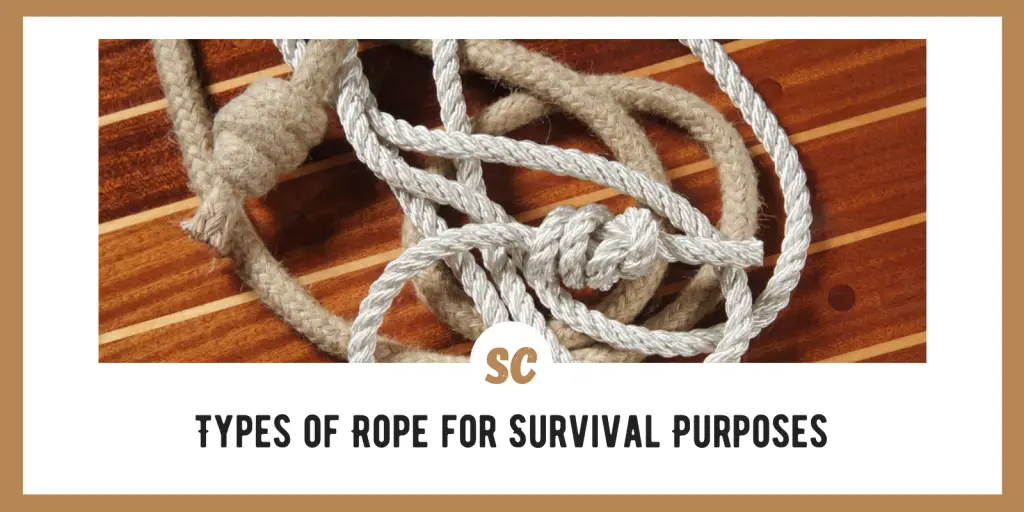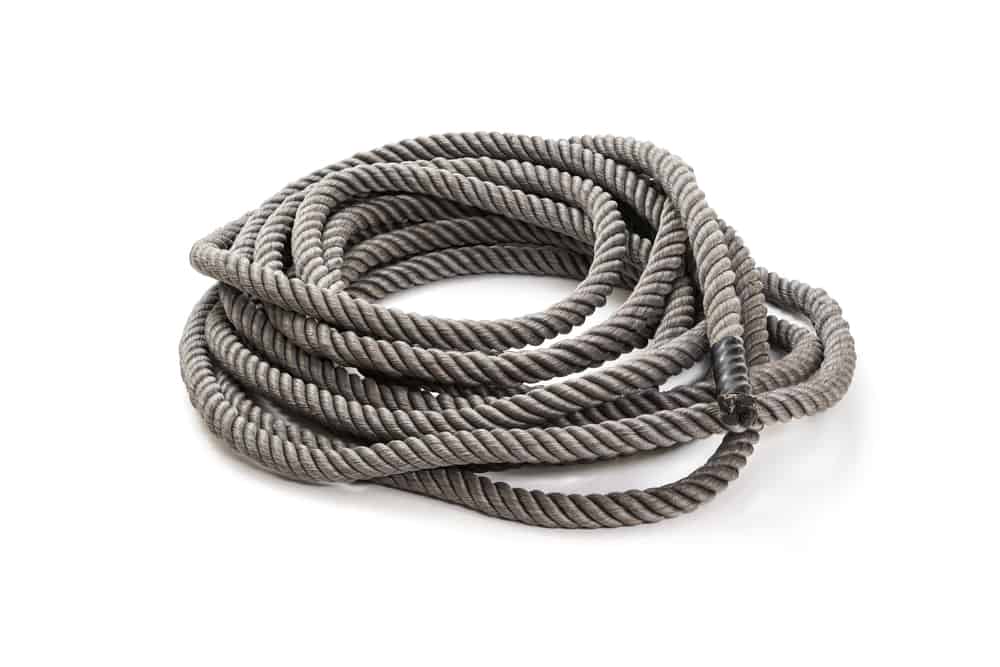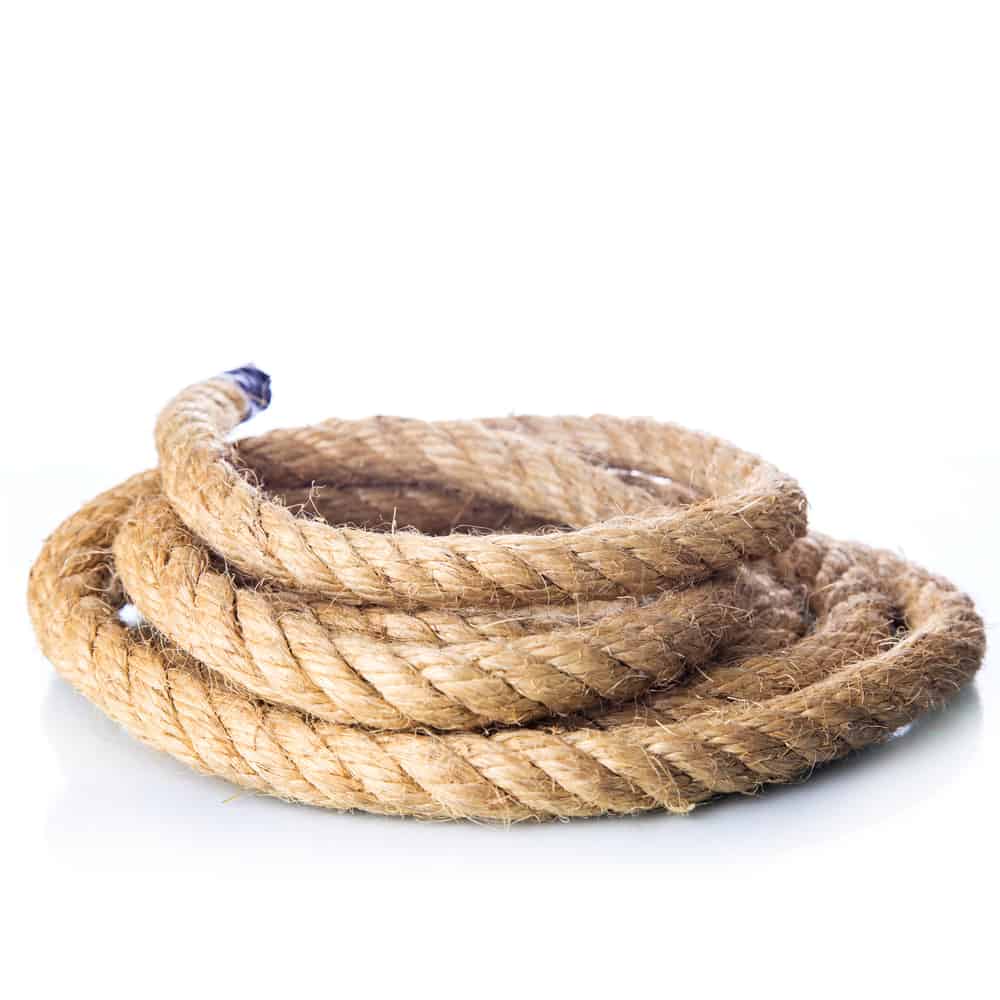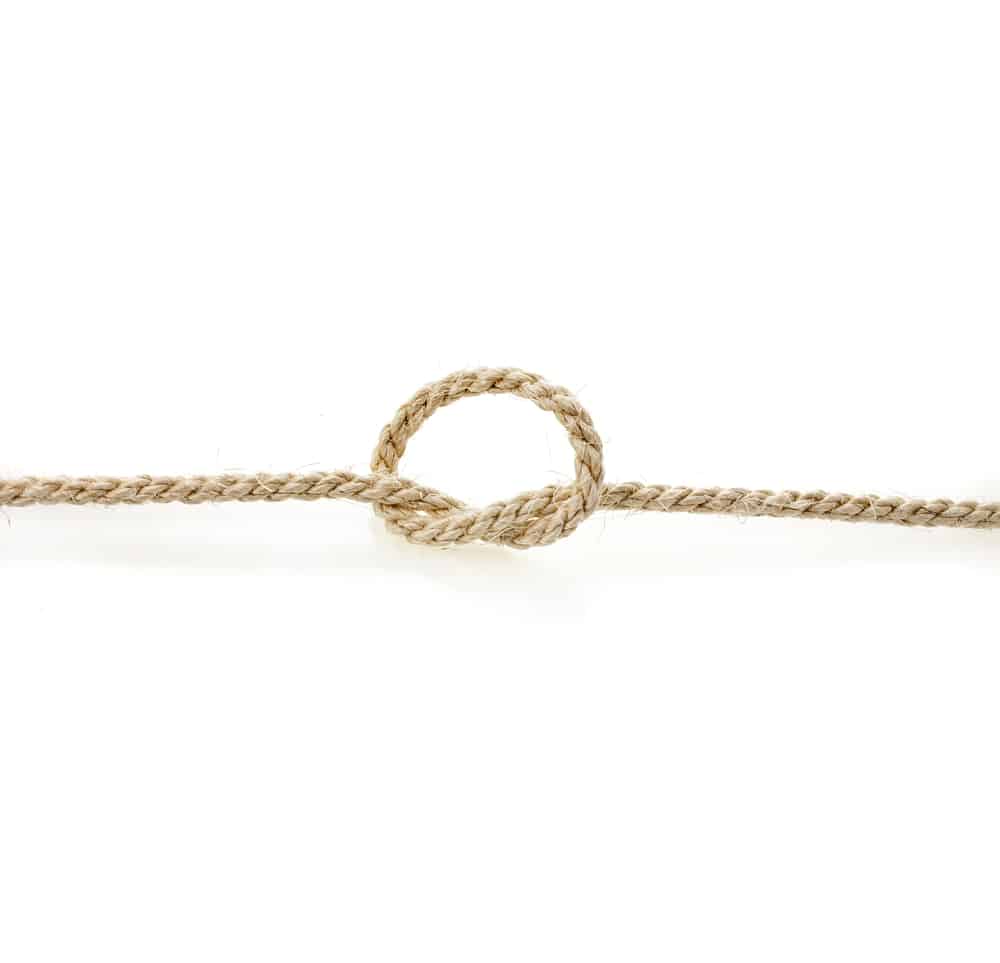A key characteristic that we look for in any piece of survival gear, is for that item to have multiple purposes. That is why cutting tools, such as knives, are among the top tools to have.

Other than a knife, one of the most versatile items to have in a survival kit or a pack is rope. It can be used for all sorts of things. From tying up bundles of gear to making a shelter, to safely traversing steep inclines just to name a few.
Today, there are many different types of ropes and cordages available to the outdoors person and it can be tricky at times trying to decide on which one to carry.
SKIP AHEAD
Choosing a Rope
When choosing a rope, it helps to keep certain characteristics in mind, such as flexibility, size, weight, whether it sinks or floats, how easy it is to work with, weather resistance, and strength.
Keeping in mind that rope is an important part of a survival tool chest and that so much can be done with it, you are going to want to choose the right one for you.
This includes considering what you will primarily be using it for and what environments you spend the most time in. Often the biggest deciding factor in carrying rope is its size and weight versus its strength.
6 Types of Rope
To begin I wanted to quickly say that some of the options below are probably considered cordage and not rope due to their size. However, they are still quite useful and popular which is why they are on the list.
Also, when it comes to a survival situation, big rope is great for certain tasks and smaller cordage is great for certain tasks. Since you never know what you may need, its good to know the options available.
Paracord
Paracord is well-known and popular to carry for outdoor/survival uses. What is not as well known is that paracord comes in different sizes.
The most widely used paracord is 550 paracord, so-called because it can hold 550 pounds, but there are smaller sizes as well.
Paracord is made from nylon, which is a synthetic material. It consists of a core of inner strands (yarns) surrounded by an outer sheath, and this design is what helps give paracord its strength.
Pros
- Affordable
- Extremely strong
- Available in different colors
- Easily taken apart
- Lightweight and compact
Cons
- Small diameter can make it difficult to hold onto
- Small diameter means it can be cut easily
- Stretches when under a load
Jute Twine
This is another small diameter type of cordage and it is usually not carried as a primary rope. However, I know of a lot of people that still carry at least some of this twine.
Unlike paracord and other synthetic ropes, Jute is constructed from the plant material cellulose and lignan. This means the twine is made from natural materials.
Jute Twine is pretty easy to work with, soft on the hands, and holds knots well. It is easy to cut and works extremely well for all manners of small tying tasks.
The twine comes in different sizes and its tensile strength will depend on the size that you choose. Its strength can range from around fifty pounds up to almost five hundred pounds.
You also will not have to worry about picking up small cut pieces because Jute is one hundred percent biodegradable. Of course, this is also a downfall if you expect to have something tied up long term.
Another great reason to carry jute is that it makes an extremely good fire starter. Simply rough up a small handle full of dry Jute, make a bird’s nest and you have yourself a material that takes a spark extremely well.
Pros
- Lightweight and compact
- Affordable
- Biodegradable
- Comes in different sizes
- Holds knots well
- Easy to work with
- Soft on the hands
- Makes an excellent fire starter
Cons
- Will degrade over time
- Retains moisture
Sisal Rope
Sisal rope is another natural rope because it is made from plant fibers. Like Jute, it can be found in small diameter twine up to larger diameter ropes.
Unlike Jute, Sisal tends to be much coarser feeling, which can be rough on the hands. It also tends to hold its shape once it has become wet and dried. This can make untying knots more difficult.
Since it is made from natural materials, sisal rope is biodegradable meaning it will degrade over time, but it also works well as a fire starter.
Pros
- Affordable
- Stronger than Jute
- Biodegradable
- Can be used as fire tinder
- Available in different sizes
Cons
- Can be rough against the skin
- Holds its shape after becoming wet and drying
Kevlar Rope
Kevlar rope is another synthetic rope made from poly-parahenylene terephthalamide, that gives it unique characteristics. It is the strongest rope on this list and interestingly when all else is equal, Kevlar rope is stronger than steel. In some instances, Kevlar rope has even replaced steel cables in construction.
Kevlar rope is also quite resistant to extreme cold and heat, ultraviolet light, water, and even fire. It does not stretch and is extremely strong. For example, a length of Kevlar rope that is 1/8” in diameter has a tensile strength of up to 1,500 pounds.
The main downsides to this rope is that it is the most expensive option on the list and the tying and untying of knots can weaken the material.
Pros
- Strongest rope available
- Doesn’t stretch
- Resistant to water, extreme temperatures, UV, fire
Cons
- The most expensive option on the list
- Knots will weaken the rope after use
Polypropylene Rope
This is another synthetic rope that is basically made out of plastic. Because of this, polypropylene rope is water-resistant and even floats when it is fully submerged in water. Also, it will not succumb to mildew.
Both of these factors make it an excellent choice if you will be spending a lot of time on or around water. Polypropylene rope is lightweight and will not rot over time.
Sounds pretty good huh? Well, there are few downsides to it. This is not the type of rope you want to use when a lot of friction is involved, due to the material it is made from.
Friction produces heat and polypropylene is prone to melting. Be sure to keep it away from any heat sources, otherwise, you will find your rope unusable rather quickly.
Ironically, even though polypropylene is a good rope to use around water for the reasons listed above, it is rather smooth and slick, especially when wet. This can make the rope more difficult to hold onto over other options on the list
Lastly, because the rope is smooth and slick it can have issues holding some knots securely.
Pros
- Affordable
- Lightweight
- Water-resistant
- Mildew resistant
- Floats
Cons
- Slick surface
- It may not hold some knots well
- Should not be used around high heat sources
Bank Line
Bank line is made from polypropylene, making it another synthetic cordage choice, and it usually black. It is often used to create trotlines for fishing, which is where it gets its name from.
Trotlines consist of tying one end of the cord to the shore (bank) and securing the opposite end to the other shore or applicable anchor point. Lines with hooks are then hung down along the length of the bank line.
Bank line typically comes in the color black because during manufacturing it is tarred, which gives it additional resistance to outdoor elements.
The most common type of bank line is #36. This type measures .085” in diameter and has a tensile strength of 320 pounds.
Even though bank line is kind of designed specifically for fishing, it can be used as general-purpose cordage for all sorts of outdoor tasks.
Pros
- Weather-resistant
- Holds knots well
- Lightweight and compact
- Affordable
- Comes in many different sizes
- Does not tangle up easily
Cons
- Usually only comes in black
- Can have a strong odor to it when brand new
- Small diameter may be difficult to hold onto
Which One is Best?
Unfortunately, I really cannot give you an answer of which one is the “ultimate” survival rope, because in my opinion there really isn’t one.
I know that I am going to sound like a broken record here, but it really depends on what you plan on using the rope for and the environment you will be in.
If rope strength is your only concern, then it seems that Kevlar rope would be the best option.
If you want something affordable, versatile, soft on the hands, and can be used as fire tinder, then Jute rope would be a good option.
However, if size and weight are of concern to you but you still want something that is strong, then paracord or bank line would be a good option.
Do you see where I am going with this?
While I do not think there is one ultimate rope, I do think there is an ultimate answer as it pertains to survival situations. Carry two different ropes.
We think of survival situations as something that is thrust upon us that we are wholly unprepared for and yes, sometimes that does happen.
However, survival situations often arise from us putting ourselves in situations when we were not prepared. Thus, proper planning was not considered beforehand.
As is the case with many tools, there is rarely one tool that is perfectly suited for everything. When carefully planned for, it is best to have two different types of ropes, usually one made from synthetic materials, and one made from natural materials.
By having two different types of rope, you will have more options and thus be able to do more in a survival situation.
Tensile Strength vs Working Load
Tensile strength and working load are two characteristics you should be familiar with. Tensile strength refers to the maximum load a rope can hold before breaking. Working load is the range of weight that it is safe to use on the rope without worrying about it snapping.
People tend to be more interested in the breaking strength because it gives us an idea of ropes full potential in a worst-case scenario. Below is a list of the tensile strength of the ropes and cordages listed in the above article.
- Paracord Type 3= 550 pounds
- Jute Twine 4 ply = 110 pounds
- Kevlar rope 1/8” in diameter= 1,500 pounds
- Sisal Rope 5/16” in diameter = 640 pounds
- Polypropylene rope ¼” in diameter= 1,125 pounds
- Bank line #36 is rated for 360 pounds
FAQs
This depends on the environments you spend the most time in and what you use your rope for. This is why smaller diameter cordages, such as paracord and bank line, are popular because one to two hundred feet can easily be carried.
The more rope that you can carry without sacrificing room for other gear, the better. When it comes to small diameter cordage it’s a good idea to carry one hundred feet at a minimum.
Some synthetics will continue to burn after lit but use caution as they will give off noxious fumes, black smoke, and will melt, producing a hot sticky residue. Generally, burning a synthetic rope as a fire starter should be avoided unless you are in a true survival situation.
Do not burn synthetics in enclosed spaces, and when it is possible, use natural fiber ropes as they make the best fire starters.
Even though type three paracord can hold 550 pounds, it is not rated as a climbing rope for various reasons. (This goes for other cordages as well) However, in a survival situation you may have to make do with what you have. Just know that your safety will be in your hands as you weigh the risks.
Wrap Up
After looking back over my list of ropes I realized two things that I should probably mention.
First, the list is not an all-inclusive list of every type of rope or cordage that is available. The options that I presented are the types I think are the most common and most useful ones to have, in my opinion.
Secondly, there are several options on the list that some people may find not acceptable rope options based on their small size. For example, paracord, twine, and bank line.
Whether it is right or wrong, I don’t see many people these days carrying a large diameter rope strapped across their chest to go on a quick outing or even to spend a few days in the woods. I can make an argument for doing so, but I won’t.
I think for the average person, small diameter cordages will suit the majority of their needs, which is why I included them.
Choosing a rope for survival purposes is not something that should be taken lightly but researched well because there are several factors to consider and your safety could depend on them.
A rope is one of those items that may work great for someone else but that does not mean it will work equally well for you. It is important to choose a rope that is right for you so that when the time comes to use it you can do so confidently.
Thanks for reading.
What are your favorite types of rope to use for survival purposes? Sound off in the comment section below and let us know!




